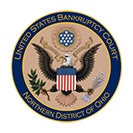Whenever a pleading or other paper is filed electronically, a Notice of Electronic Filing (NEF) will be automatically generated by the ECF system at the time of docketing, and will be sent by email to the party filing the pleading or other paper as well as to all other parties to the case who appear on the Electronic Mail Notice List in the ECF system.[1]
Each registered ECF user is permitted to view documents filed in a case in which the user is a party without charge on a one-time basis. This "free look" is available only:
- to case participants.
- through email generated by CM/ECF.
- on a one-time basis.
- for 15 days.
While the main document and all attachments are available for free, access to the docket sheet is not free.
Circumstances in which a party has been denied access to this one free look are addressed below.
-
Adobe Settings
If a blank screen appears, changes should be made in the Adobe settings. Select Edit → Preferences → Internet, and remove the check mark from Display PDF in browser and the check mark from Allow fast web view.
-
Age of NEF
If the NEF is more than 15 days old, the free look has expired.
-
ECF Account Settings
Ensure that the settings under Maintain Your ECF Account are properly marked, and that the same case is not listed under Send notices in these additional cases
-
Email Recipient
If the user is not the original recipient of the email, it is possible that the link was accessed prior to it being forwarded. If it has already been accessed, there are no additional free looks. However, there is no way for court staff to determine whether or not the free look has been accessed.
-
Electronic Stamp
Each document should contain an electronic stamp. If there is no electronic stamp, the free look will not function; the electronic stamp is the key to bypassing the PACER login screen.
-
Security Settings
In many cases the security settings on a user's network cause problems with the free look. A party should establish an email address outside of the company/firm's network, and add that email address to the recipient list under Maintain Your ECF Account. The user should view a future notice from this secondary account. If he or she is able to view it free of charge, then the user's IT staff should be consulted in order to diagnose the network issue.
-
Mail Server Configuration
Sometimes a user's email configuration may cause an issue with the link and the browser, and the setting would need to be reconfigured. Select File → Preferences & Locations → Internet, then select a browser such as Internet Explorer. (These settings may differ depending on the user's email server.)
-
Pop-up Blockers
Pop-up blockers may be the cause of the problem with the free look. The procedure for disabling pop-up blockers varies depending on the user's browser. On the menu bar in Internet Explorer 7 and 8, select Tools → Internet Options. Click on the Privacy tab and make sure the checkbox labeled Turn on pop-up blocker is unchecked. Click OK when done.
On the menu bar in Mozilla Firefox, select Tools → Options; then go to the Content tab and make sure the checkbox labeled Block pop-up windows is unchecked. Click OK when done.
-
Private Documents and Locked Transcripts
Private documents and locked transcripts are only viewable to court users. While parties to the case who appear on the Electronic Mail Notice List in the ECF system will receive a NEF, since the document is not viewable, a free look is not permitted.
If a user is still unable to resolve the problem after attempting these fixes, he or she should contact the appropriate Clerk's Office Help Desk. Help Desk staff can add their email address to the case under the attorney's ECF account. This will cause an NEF to be forwarded to the Help Desk staff's email account. If the link functions, the issue is most likely a personal setting on the user's PC, email setting, or network.
- ^ An NEF is not generated when a proof of claim is filed or a proposed order is submitted to the court.
